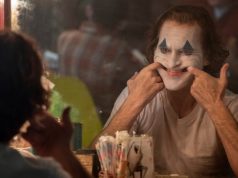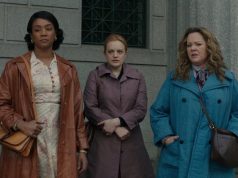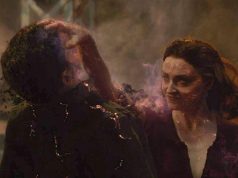(Written for a 2002 “Reviewer Rumble” tournament among eFilmCritic.com contributors.)
When the conversation turns to high-quality film adaptations of beloved comic books, certain films will invariably crop up. “Spider-Man” will be mentioned, as will the original “Superman” and the first “Batman,” and maybe “X-Men.” But what happens if you bring up “Teenage Mutant Ninja Turtles”? The other people avoid your glance, shuffle their feet and awkwardly change the subject, that’s what. “Teenage Mutant Ninja Turtles” was a bad adaptation of a comic book that was highly questionable to begin with. You should have known that; it serves you right that now your movie friends think you’re a moron.
In our analysis of this 1990 film, which starred no one and spawned two even more no-one-starring sequels, we must begin by accepting one thing: No film whose premise is that radiation can turn turtles into humanoids can be worth more than $1.50. If a person paid full price to see this movie, knowing full well what it was about, well, again, it serves that person right.
According to the lore put forth in the film, 15 years earlier — 1975, that would be — a rat by the name of Splinter happened upon four baby turtles who were crawling around in radioactive waste, as turtles are wont to do. The turtles and the rat began growing at an alarming rate, and they even learned to speak English, though I’m not sure how that happened, since they lived in the sewer and had no human contact. Anyway, they learned it, and the turtles immediately began speaking in 1980s slang, despite it being 1975, 1976 at the latest. That’s how highly evolved they were.
Now, in the present day, they are pizza-loving teen-agers, named by Splinter after various Italian artists: Donatello, Michelangelo, Raphael and Leonardo. The happy fivesome has a cozy subterranean dwelling in the sewers of Manhattan, and probably pay more rent on it than you would for a studio apartment in SoHo. Splinter has trained the teen-age mutant turtles in the art of ninja warfare, but has also insisted they stay out of sight, except that Raphael is allowed to put on a hat and trenchcoat and walk the streets, so frankly I’m not sure Splinter really knows WHAT he wants. Parenthood was kind of thrust upon him, and I suspect four active teen-age boys are more than an elderly Japanese rodent can fairly be expected to handle.
On the streets above them, Manhattan is embroiled in a crime wave perpetrated by hooligans so well-trained that no one ever even sees them, much less catch them in the act. After hearing this information delivered by a TV reporter named April, we promptly see April stumble right into the middle of a heist, thus both seeing them and catching them in the act, which is either an extraordinary coincidence or a bad plot device. She is rescued from the criminals by the TMNTs, all of whom are smitten with her beauty. (This is where it’s apparent the boys have spent too much time away from society, as April is average-looking at best. Also, let us not contemplate the sorts of lustful images that must run through the mind of a hormonal teen-age turtle.)
April befriends them, as does a weird hockey-playing renegade named Casey Jones. I’m not sure how he fits into the equation, exactly; one minute he’s fighting with Raphael, the next minute he’s friends with everybody. I figure the screenwriters wanted him to be in the movie, couldn’t figure out how to get him there, so they just threw him in randomly and hoped we wouldn’t notice.
The thieves, it turns out, are part of a highly efficient organization called The Foot, run by a Darth Vader-ish fellow named The Shredder. He also commands an army of stealthy ninjas, which is good, because it means the TMNTs will have a lot of people to fight. Fight scenes in movies like this are like sex scenes in porno movies: You can tell the dialogue exists solely to lead up to them, and they’re the only conceivable reason you’d ever watch the thing. In fact, one line in this movie — “Looks like you’re the one who needs to be taught a lesson” — sounds like it could lead to either a fight OR a sexual encounter. (In this case, considering it is delivered by Casey Jones to Raphael, I am glad it turned into a fight.)
The turtles had not particularly considered themselves a crime-fighting task force, but then Splinter gets rat-napped by Shredder, so what can you do?
The movie has some memorable dialogue, but not the way the movie intended it. One of Shredder’s ninjas approaches April at one point and says, “I de-river a message to you,” which is so ethnically inconsiderate that it amuses me greatly. Another time, one of Shredder’s lackeys says, “Why do the turtles trouble you, Master?,” which has that rare quality of being as nonsensical out of context as it is in.
The dialogue the movie thinks is good is actually bad. For example, this exchange between one of the turtles (they all look and sound alike) and Casey:
TURTLE: You’re a claustrophobic.
CASEY: Hey, I’ve never even LOOKED at another guy.
Men were paid money to write these words, and other men were paid money to speak them.
Throughout the film, the title characters look like men in turtle costumes. Even after suspending my disbelief, I can’t get past the fact that they look nothing like actual turtles. Maybe if their shells didn’t bend every time someone touched them, or if they ever retracted their heads or arms into their bodies. Maybe if they died after two weeks and Splinter flushed them down a toilet.
In terms of action movies aimed at young, developmentally disabled children, this one is harmless and unmemorable. But let us all be grateful the Teenage Mutant Ninja Turtle craze died out as quickly as it did, and that more than a decade has passed since then. We as Americans can be forgiven for that brief indiscretion, considering how long we’ve been clean now.
D (1 hr., 33 min.; )





